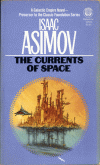It has been a while since I have read anything by Timothy Zahn. I loved his Star Wars Thrawn Trilogy and Hand of Thrawn Duology. I also enjoyed the Conquerors’ Trilogy. I’d like to go back and re-read those sometime in the future, but for now I’m focusing on chipping away at my collection of books I haven’t read yet. I was very pleased at how well Zahn developed the Zhirrzh in the Conquerors’ Trilogy, so I was curious to see how well he does here in Manta’s Gift.
The Qanska are not the typical aliens you would expect so see in a Sci-Fi novel. They look like huge manta rays flying through the various levels of ever thicker atmosphere in Jupiter. The vast majority of aliens that I have read about have been humanoid. The ones that are not humanoid are usually portrayed as monsters (Starship Troopers), or there is a huge communication gap. Zahn challenges this stereotype and succeeds in describing a completely unique and intelligent alien race.
Several years after first contact in Jupiter’s atmosphere, scientists learn to communicate with the Qanska through tonals, which seem to me kind of how whales communicate. Computers are designed to translate between English and Qanskan, but the functionality isn’t as good as expected. To overcome this, a radical plan is devised which will bring humans and Qanskan closer together. The Five Hundred, a group of the most powerful humans, sponsors this project.
Project Changeling’s goal is to send a human ambassador to be reborn inside a Qanskan body. (This is what drew me to this book in the first place).Once the transformation is complete, the new being will have the mind of a human but physiology of a Qanska. It turns out that both the humans and Qanska have motives other than simply developing stronger diplomatic relations and better communication. Early on it is revealed that The Five Hundred suspect that the Qanska possess a stardrive capable of interstellar travel, since it is estimated that they have only inhabited Jupiter for a few hundred years. The Qanskan motive isn’t revealed until much later.
Qanskan culture is described through the eyes of Raimey, a paraplegic given the chance to be reborn through Project Changeling. We learn the details of Qanskan life one bit at a time as Raimey does. Also, there is a complex ecology including predators, prey, and plant life. I never pictured that life could be possible on Jupiter, but Zahn makes it seem plausible. It is obvious that Zahn spent quite a bit of time developing the Qanska.
Project Changeling is touted as a scientific mission, led by Jacob Faraday, one of the first explorers to make contact with the Qanska. He is given full control of the mission, with Raimey’s welfare as his top priority. Sure enough, that doesn’t last very long because Arbiter Liadof is sent to Jupiter to “oversee” how the progress going. Liadof reveals for the first time that the true goal of the project is to locate and obtain the stardrive.
The Five Hundred expect that Raimey, now known as Manta, will remain loyal to humans once they reveal their plan to uncover the stardrive. However, Raimey/Manta develops his own set of priorities as he develops into a full grown Qanskan. Not only does transform physically, but emotionally as well. At his core he had been an extremely selfish person, but he eventually learns to prioritize others above himself. The Five Hundred are determined to obtain the stardrive whether Raimey/Manta is willing to help or not.
The outcome is very uncertain as Zahn unleashes plenty of surprises as the plot progresses. There is a fair amount of action, but the bulk of the book focuses on Raimey/Manta’s transformation and the depiction of Qanskan society. The conclusion was unexpected, yet satisfying. This was an enjoyable book and a somewhat fast read at just over 400 paperback pages. If you want a truly unique experience, read Manta’s Gift. You will not be disappointed.


